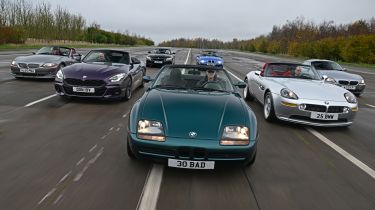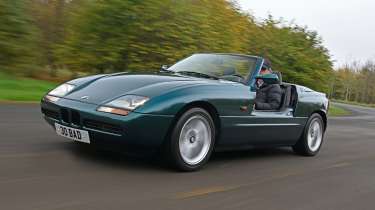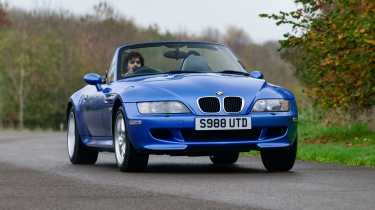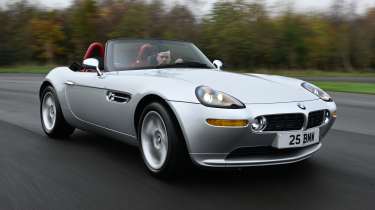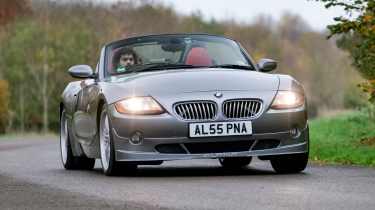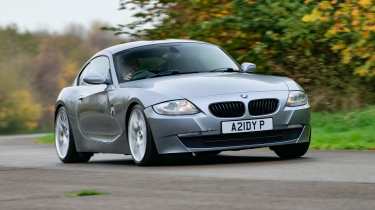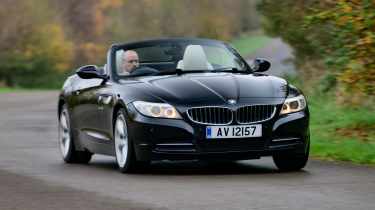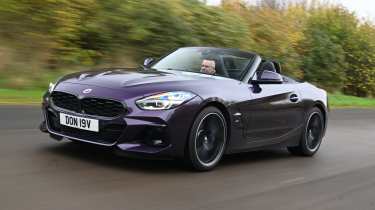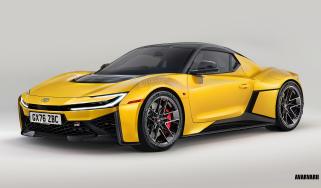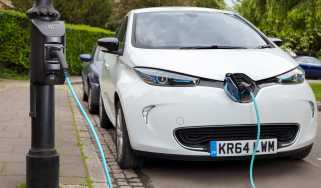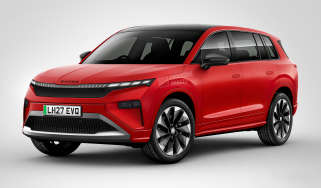BMW Z car supertest: Z1, Z3, Z4 and Z8 help us celebrate 35 years of Bavarian roadsters
It’s been 35 years since BMW’s first Z car. We’ve brought all seven together for a two-seat supertest
Ask any car fan how they perceive BMW, and we’d wager that it wouldn’t take long to get on to the topic of performance cars. Driving thrills have been one of the strongest parts of the brand’s identity for what seems like forever; from hot hatches to performance saloons, from supercars to – more recently – fire-breathing SUVs, the marque has always had it covered.
It might be a surprise then, that last century BMW went for almost 30 years without a sports car on its books. When production of the iconic 507 ended in 1959, a two-seat drop-top took a long time to return. Everything changed three decades later, when the first Z1 rolled off the production line, a step which rejuvenated the manufacturer’s love for the sports car.
This year, then, marks 35 years since the first Z car, resulting in a near-unbroken run of convertibles that has continued to this day through six different iterations. We’ve brought all of them together here – in standard UK cabriolet weather – kicking off with the car that started it all and moving through the range. It’s clear that while each model manages to offer its own distinctive character, some obvious family ties have remained throughout.
BMW Z1
- Engine: 2.5-litre 6cyl
- Power/torque: 170bhp/222Nm
- Transmission: Five-speed manual, rear-wheel drive
- 0-62mph: 7.9 secs
- Price new: £36,925 (1989)
- Value today: from £35,000
More reviews
Car group tests
In-depth reviews
Road tests
- BMW Z4 M40i Handschalter review: a manual roadster that’s delightfully old-school
- New BMW Z4 M40i 2023 facelift review
- New BMW Z4 M40i 2019 review
- New BMW Z4 sDrive20i M Sport 2019 review
Used car tests
While the Z1’s release might seem like a long-overdue reaction to filling a three-decade-long gap in BMW’s range, its inception followed on from what wasn’t exactly the most normal development process.
In 1985, the BMW management wanted to set up a team of engineers that focused solely on developing cutting-edge tech. The group would give some of the marque’s 60-or-so brightest minds the freedom to work on creative concepts away from the regular production grind. The department became known as BMW Technik GmbH – known as ZT for short.
The first fruits of this labour was a car which employed new materials, enabled quicker development times, and provided new suspension designs. The Z-axle this newcomer employed would later find its way into production on the E36 3 Series. That car was the Z1.
Executives loved the design so much that this one-off development vehicle was given the green light for production. A production-ready car was revealed to the press in autumn 1988, with deliveries commencing the following year.
A desire for sportiness was the aim here, setting it apart from many competitors’ larger, softer alternatives. As a result, the Z1 was strictly two-seat only, with its dimensions compact even by
the standards of the late eighties.
Today, it really looks tiny in the metal. At no more than four metres long, it takes up less space on the road than a modern supermini, and at less than 1.7 metres wide and just 1.2 metres tall, it’s dinky in every direction. But that only enhances its jaw-dropping design. The low nose has an understated iteration of BMW’s signature kidney grilles, and from there curves upwards towards a squared-off rear end. The Z1 is made all the more stocky by its wide track and wheel-at-each-corner stance.
But the real party piece comes right in the middle, because the Z1 sports a set of doors like no other car on the planet. Pull the handle, and rather than opening outwards, the door drops electrically into the side sill. It’s pure theatre, and better still, you can drive with them in the open position.
But before you set off, there are two hurdles to overcome. One is literal; the need to package that door – plus provide enough rigidity to the BMW’s structure – means that the sill is both high and wide. It’s also trimmed in leather, so getting in takes a big stride over the threshold while clinging onto the windscreen frame.
The second hurdle is that, unless you’ve stumbled across one of the rare models that were converted to right-hand drive, all Z1’s had their steering wheel on the left. It’s a beautiful wheel, though – one that looks wonderfully simple now that we’ve become accustomed to an era where most are festooned with buttons.
Once inside, you’re presented with a dashboard which, in contrast to the exterior, appears entirely logical and easy to figure out. There’s shades of the E30 3 Series here; unsurprising, because that Z-axle aside, the Z1 was based on a shortened version of the contemporary 325i’s underpinnings.
But out on the road, it feels like nothing else. Driven with those doors down, the Z1 delivers a feel-good factor that’s hard to replicate with other sports cars. The BMW may have been considered sporty in its day, but against so many firmly riding performance cars of today, the ride is wonderfully soft and forgiving, making it a very relaxing cruiser.
It’s not short on involvement, though. Get over the slight dead spot in the steering around the straight-ahead, and there’s feedback through that slim rim, revealing a chassis that has a surprising amount of grip for a 35-year-old car. As with any performance BMW, it’s neatly balanced, too.
This stunning example, provided by its owner Rob Norton, has gained a little extra pep courtesy of a Hartge conversion. The engine capacity has been bumped from 2.5 to 2.7 litres courtesy of a longer stroke. Increased compression and a revised ECU add 35bhp, while an extra 34Nm of torque arrives sooner than in the standard model. The result is that nearly a full second is knocked from the standard car’s 0-60mph time, down from 7.9 seconds to 7.0 seconds. It’s a really sweet spot though, delivering a hearty yet not dramatic level of speed which feels perfectly suited to the Z1’s character. And what a huge amount of character
it has – it’s certainly a tough act to follow.
BMW Z3
- Engine: 3.2-litre 4cyl turbo (Z3 M)
- Power/torque: 317bhp/350Nm
- Transmission: Five-speed manual, rear-wheel drive
- 0-62mph: 5.0 secs
- Price new: £40,600 (2000)
- Value today: from £11,000
While the Z1 was very much a rare (and expensive for its time) offering, BMW saw that there was potential for a much more mass-market approach for its replacement. And boy did the Z3 succeed commercially. While just 8,000 Z1s were produced, almost 300,000 Z3s hit the road in a seven-year period between 1995 and 2002.
To achieve this, the latest model took a more pragmatic approach to its production – and that went beyond the return to a normal set of doors. The new mechanical make-up included a certain irony, too; while the Z3’s spiritual predecessor pioneered the rear axle that became popularised by the E36 3 Series, the Z3 used the platform adapted from the E36 3 Series Compact, which meant it missed out on the clever Z-axle rear suspension design and instead used the set-up from the older E30 3 Series instead.
There were some technical quirks under the bonnet, too. To appeal to the masses that had already fallen for the Mazda MX-5, four-cylinder power was offered from launch. The 1.9-litre, 120bhp unit didn’t exactly deliver sprightly performance – and even a bump to 138bhp later in its life didn’t turn it into a fire-breather.
Much better suited to the Z3’s muscular shape was the M52 2.8-litre straight-six taken from the 328i. This offered up 189bhp, lifting it well beyond the Z1’s output, and gave it a 0-62mph time of 7.1 seconds, comfortably beating the standard that was set by typical mid-nineties hot hatches.
The example here is the Z3 M Roadster that took not only its power from the M3 – a 3.2-litre inline six producing 317bhp and a 7,600rpm red line – but also its limited-slip differential and beefier brakes.
While the M3 takes much of the glory, we’d argue that the Z3 is among the best places from which to appreciate one of BMW’s greatest engines. Roof down, there’s a gloriously rich howl from the motor as it’s wound through its full rev range, while those oversized rear tyres let you to deploy everything it’s got far more often than you first realise. A beautifully linear power delivery helps here, too; it may shriek like a barely restrained race engine, but it’s really quite friendly, too. That motor dominates the whole experience, adding a sense of rawness that makes you feel connected to the model.
Even its quirks only add to the charm. It’s not the sharpest or most precise car to point into a corner, but the steering and the gearshift have a beefy feel that seems perfectly suited to the Z3’s overall vibe. The cabin is very snug – the windscreen is close to the dash and the elbow room is tighter than you might expect – but that only adds to the feeling that the occupants are bit-part extras behind the A-list engine crammed under the bonnet.
Get over the tightness inside and the Z3’s cabin oozes quality. From the solid action of the chrome-bezelled heater controls to the clarity of the dials and the wonderfully supportive seats, it all adds to the occasion. So do the quad tailpipes at the back – the first time a BMW M car used that arrangement and one that has been found on every M car since.
Yet despite all of this, values of the Z3 M Roadster mean it isn’t as unobtainable as you might think. While the finest examples of its hard-topped sibling, the rare and quirky breadvan-shaped Z3 M Coupé, fetch £50-£60,000 in immaculate condition, the drop-top version starts from less than half that sum. Roadsters are cheaper still, kicking off from £10,000.
Still too much? Then Z3s can be found on sale for as little as that ever-popular Mazda MX-5. High-mileage examples of the 1.9-litre petrol Z3 start from as little as £1,000, and while 2.8 models can fetch much more in show-ready condition, there are plenty of examples around for a few grand. Little else at that price offers muscle-car looks with a glorious six-cylinder sound.
BMW Z8
- Engine: 4.9-litre V8
- Power/torque: 394bhp/500Nm
- Transmission: Six-speed manual, rear-wheel drive
- 0-62mph: 4.7 secs
- Price new: £86,650 (1999)
- Value today: from £160,000
Here it is, then: the most exclusive and valuable Z car of them all. The Z8 was first teased by the Z07 concept shown at the 1997 Tokyo Motor Show, but the greatest shock two years later was that the production version had hardly changed at all. It looked every inch like a show car for the road. Or should that be a movie star for the road? After all, this was the car which James Bond drove in the The World is Not Enough.
The Z8’s silver screen-worthy looks, penned by Henrik Fisker, paid homage to the stunning 507. From the round headlights to the wide, slim iteration of the signature BMW kidney grille, and the vents in the front wing, the inspiration for the Z8’s design is clear to see.
But that retro shape doesn’t diminish its spectacular presence in the metal; it looks truly stunning up close and worth every penny of the £160,00-250,000 they fetch in private sales today. Like many movie stars, it’s perhaps not quite as big as you expect in the metal. At 4.4 metres long and 1.8 metres wide, it takes up almost exactly the same space on the road as a Nissan Qashqai.
The BMW’s styling is no less spectacular inside, with bespoke components everywhere. The switchgear, the steering wheel and the entire leather-trimmed dashboard are all unique to the Z8. The dials sit in the middle of the dash and are angled towards the driver. Like the Z1, the Z8 was only ever produced in left-hand drive.
It did borrow an engine, however, but it’s no bad place to start. Power comes from the same 4.9-litre V8 that drove the legendary E39 M5, which means 394bhp and 500Nm of torque sent to the rear wheels through a six-speed manual gearbox. Unlike the contemporary M5, however, the Z8 didn’t employ a limited-slip differential to help get all that torque onto the road, but it did get rack-and-pinion steering, which was more precise
than the recirculating ball set-up used by every other V8-powered BMW up to that point.
An aluminium spaceframe construction and lots of aluminium in the suspension kept the model’s weight down to a reasonable 1,585kg.
Feedback from the motoring press was a little lukewarm at the Z8’s launch, with testers unsure about what it was trying to be. Time has been kind to the car’s driving experience, though; it makes far more sense now than it did back in 1999. With sports cars becoming ever firmer and sharper in the intervening 25 years since its launch, the Z8 has found its place as a relaxing cruiser – albeit one with the heart of a V8 bruiser. With the roof down, it’s easy to appreciate that thunderous V8 soundtrack. Plant your right foot, and the Z8 squats onto the rear axle as it launches forward at pace. There’s only a slight let-up as you work the gearbox through its long throw before the surge continues. This is a very quick car even by modern standards.
But ease off and that engine remains wonderful to use. There’s loads of low-down torque, allowing you to hold a gear and enjoy a V8 burble that still sounds lovely when it’s not working as hard. And that suits the rest of the driving experience, too. The Z8 isn’t a car to push into corners – it feels too soft, the steering too slow and the balance a little nose-heavy for that – but instead you appreciate its other qualities. The ride comfort is much smoother than any modern two-seat drop-top, and refinement is still impressive – especially with the roof up.
BMW Z4 (E85/86)
- Engine: 3.4-litre 6cyl (Alpina Roadster S)
- Power/torque: 295bhp/362Nm
- Transmission: Six-speed manual, rear-wheel drive
- 0-62mph: 5.0 secs
- Price when new: £37,850 (2006)
- Value today: from £20,000
By the year 2002, the Z3 had been with us for some time, and the slight hotch-potch of its mechanical make-up was replaced by a more coherent mechanical package for its successor. This time, the underpinnings were taken from the E46-generation 3 Series.
With it came a radical new style that was much more modern inside and out. Gone was the retro look, replaced by something radically contemporary; its sharp creases and bold angles are impossible to miss whichever direction you approach from.
The model we’re driving here is even more dramatic looking than most. This is the Alpina Roadster S, and the German tuner added its own signature multi-spoke alloy wheels and menacing bodykit. This immaculate example, provided by owner Andrew Gallant, is a fitting car to include here, given that BMW now owns the Alpina brand.
As you’d expect from Alpina, the upgrades go well beyond the styling tweaks, the beautiful blue dials, and the optional extended leather package that coats much of that distinctive cabin in soft hide. An uprated version of BMW’s S52 inline six has been expanded to 3.4 litres, gains a unique cylinder head, uprated crankshaft and high-strength pistons – the result being 295bhp at 6,300rpm. From rest, 60mph arrives in just five seconds, and this example feels totally good for it.
But this Roadster also boasts a chassis that is far sharper than in its relatives here, even though it’s still backed up by Alpina’s knack for creating a wonderfully forgiving ride out of impossibly thin rubber wrapped around 19-inch wheels. It’s the keenest to turn into corners, the pedals are best placed for heel-and-toe downshifts, and it doggedly resists body roll through the turns.
But these were all traits that could be found on even the most humdrum Z4 models, granting those with barely £2,000 to spend today a really keen driver’s car. Early models suffered from a harsh ride, thanks in no small part to BMW’s decision to fit run-flat tyres in place of a spare wheel, but modern tyres take the edge off.
These were all qualities which came to a crescendo in the hot 338bhp M version, which is the best to drive of the bunch. Indeed, a little less than two decades ago when our sister title Evo magazine tested the Z4 M against not only the Alpina Roadster S, but the Porsche Boxster S and the TVR Tuscan, it emerged victorious, because
it “exhilarates and challenges in a way the oh-so-accomplished Porsche can’t match”.
BMW Z4 Coupe (E86)
- Engine: 3.0-litre 6cyl
- Power: 261bhp/315Nm
- Transmission: Six-speed manual, rear-wheel drive
- 0-62mph: 5.7 secs
- Price when new: £31,320 (2006)
- Value today: from £5,000
While the Z3 Coupé was only offered in hottest M form, making it a very rare sight on UK roads, the hard-top Z4 was also offered with a 261bhp 3.0-litre straight six. Its rarity still makes it fairly valuable on the used market, with high-mileage cars starting from £5,000, but climbing to as much as £18,000 for the most immaculate versions with barely 25,000 miles on the clock from new. The M models range from £13,000 to double that figure, depending on condition.
Looks are very subjective, but to us the proportions of this Z4 generation – and particularly the coupé – just look spectacular. It’s at its best in profile where those dramatic side creases in the door play perfectly with one another; the front line that flows up through the beautifully detailed side repeaters and up into the A-pillar is a particular highlight. This car, brought along by owner Andy Page, looks even more special with its arches filled by its E46 M3 CSL-style 19-inch wheels. Of all the cars created during the Chris Bangle era of BMW – although the car itself was penned by current Rolls-Royce director of design Anders Warming – it’d be a bold person to suggest that any others have aged so gracefully as the Z4.
And of all the models here, it seems like this one was the right version to turn into a coupé. The extra stiffness of a solid roof applied to what was already the most focused driver’s car here makes it a very sharp tool. It’s a huge amount of fun to drive, with the same cab-rearward driving position of the roadster giving the feeling that you rotate with the rear axle, yet with the added benefit of the extra rigidity that comes with that shapely solid roof.
It’s a proper driver’s car, too, and while it doesn’t quite have the delicacy of a contemporary Porsche Cayman, it’s all the better for it. There’s more personality and a more playful attitude, backed up with a slight hard edge that makes you feel like you have to work to get the best out of it. Whether you choose the 3.0-litre we’re driving or that full-fat M model, they offer a wonderful soundtrack, too.
BMW Z4 (E89)
- Engine: 3.0-litre 6cyl (sDrive30)
- Power/torque: 254bhp/310Nm
- Transmission: Six-speed auto, rear-wheel drive
- 0-62mph: 6.1 secs
- Price new: £34,430 (2009)
- Value today: From £8,500
While all six Z cars were available as a two-seat roadster, two more, as we’ve seen, were also offered as a coupé. But the Mk2 Z4 was the only one that was offered as both in the same car. That’s because, in a unique move among all of the Z cars, this E89-generation Z4 was equipped with a metal folding hard-top, a move BMW made in response to the sales success that was the Mercedes SLK of the era.
BMW claimed that this metal origami meant only a modest 30kg weight penalty compared with the fabric roof of the earlier Z4, which owners would be more than willing to accept given the extra security and refinement it brought. While it takes just 21 seconds to operate at the touch of a button, when the roof is folded away it does eat into boot space, chopping an impressively roomy 310-litre volume with the seats up down to 180 litres when stowed away.
Roof design aside, the E89 carries a clear styling evolution over from the previous Z4. Yes, it became softer and a little curvier, but many of the original calling cards remain; the long bonnet/cab-rearward design and the line which curves gradually from the tail edge of the headlight towards the rear wheelarch maintain a strong resemblance with the rest of the family.
The interior is a fantastic place to sit, too. A rounded instrument binnacle ahead of a driver who can adjust the seat very close to the floor if they choose, makes you instantly feel like you’re behind the wheel of a serious sports car. Look closer, and it’s the details that make the cabin really stand out; the chrome-ringed climate controls, whose functions are all split into four circles, are as beautifully finished as they are logical to use. Touches such as these made high-end cars feel special in the past, and it’s a tactile quality that so many modern, touchscreen-laden models struggle to replicate.
On the move, the Mk2 Z4 returns much more to Z-car type after the exception that was the first Z4. Much like the Z1 and the Z3, ultimate sharpness through the turns has been traded for comfort, but with lots of power and a rear-wheel-drive chassis, there is still fun to be had. As we said when we pitched the Z4 against a Porsche Boxster and the Mercedes SLK back in June 2009: “it generates lots of grip, the steering is direct and body control excellent”. And those sentiments still ring true today. The engine is even more creamy than the marque’s previous six-cylinder efforts, too, and while the six-speed automatic gearbox isn’t quite as responsive as the dual-clutch transmission that was fitted to later four-cylinder versions of the Z4, it is still very smooth in everyday use.
In many ways, this will feel like it’s the most appealing option for fans of BMW sports cars who want a modern classic right now. It feels fresh enough to drive, almost like it could have rolled out of a showroom yesterday, yet still maintains the superb analogue clocks and logical switchgear that made BMWs of the past feel so special.
While we didn’t think it was ultimately as sharp as a Porsche Boxster to drive in period, it felt more special, and was also cheaper to buy by some margin. Indeed, it’s a model that we still think has a huge amount of appeal on the used market today. High-mileage examples with smaller engines start from £4,000, with the more potent sDrive30 driven here costing little more than £7,000 for a car without an astronomical mileage. But expect to pay slightly more for a car in the condition of owner Chris Christoforou’s example here.
BMW Z4 (G29)
- Engine: 2.0-litre 4cyl turbo (sDrive20i)
- Power/torque: 194bhp/320Nm
- Transmission: Eight-speed auto, rear-wheel drive
- 0-62mph: 6.6 secs
- Price new: £45,170
- Value today: From £18,180
Bringing all of the previous Z cars into perspective is the modern-day Z4. First released in 2018, it boasts oodles of contemporary technology, and provides tangible proof that there are plenty of positives to the systems that current models are now furnished with.
Once again, the Z4 takes a 3 Series as its starting point, although more broadly speaking it uses a variant of the brand’s Cluster Architecture (CLAR) design used by the overwhelming majority of BMW’s line-up. That enables the latest model to be packed with the sort of safety technology and structural strength that its predecessors can only dream of. When it was tested by Euro NCAP in 2019, the model received a maximum five-star rating, and its Adult Occupant Protection score of 97 per cent was one of the highest of any car that was assessed that year.
Design-wise, there’s elements of Z8 present here, from the swept-back headlights to the rounded boot and slim tail-lights. But it still features the latest BMW staples, including enlarged kidney grilles and purposeful-looking
air intakes in the front bumpers.
Initially, the roof looks like a backward step from its metal-capped predecessor, because here it reverts back to a fabric hood. But the benefits are clear, both in terms of packaging and utility.
A fabric top can fold into a much tighter space than the complex metal contraption of the E89, and the latest Z4 is amazingly practical as a result. Yes, the boot opening is typically small, as it would be in any two-seat roadster, but there’s still 281 litres of space to play with – easily enough for a couple of big suitcases to be stowed away.
There are big benefits if you’re caught out by bad weather, too. At a quick flick of a switch, the roof closes in just 10 seconds, and can be operated at speeds of up to 31mph, so there’s not even any need to come to a halt as the heavens open.
So the roof presents some practical benefits, but BMW’s engineering progress is immediately clear to see. Just a few metres along the road is enough to show just how rigid the Z4’s body feels besides its predecessors; shimmies and twitches are near non-existent from this structure, and that has allowed BMW to tune a much tighter degree of control into the chassis.
Aim the Z4 for a string of corners and it hardly rolls at all, while the electric power steering
helps the car dart into a corner with a more instantaneous feel than its ancestors; many drivers would incorrectly assume that it’s the new car that is the lightest of the bunch. Despite this, it still returns the supple, easy-going ride which made the older Z cars so adept at long-distance touring.
While turbocharging crept into the E89-generation Z4 later in its life, it’s only the current G29 model that uses turbocharging from the outset. Things kick off with a 2.0-litre petrol, and while a four-cylinder felt fairly hamstrung in the Z3, here there’s much more go; indeed, with 194bhp on tap, it’s more potent than the older car’s 2.8-litre model, especially with so much low-down torque and a superb eight-speed auto to work with.
But the real performance comes once again from six cylinders. The range is topped by the 3.0-litre M40i, which ups the power to 335bhp and 500Nm. That’s enough for a flat-out acceleration run that dispatches the 0-62mph time in just 4.5 seconds.
Earlier this year, BMW bolstered the all-auto range with the Handschalter package, introducing the option of a six-speed manual transmission to the M40i. While it adds 0.1 seconds to the 0-62mph time, it more than makes up for it with the level of feel and interaction of that extra pedal. Indeed, for all of its modern tech and touchscreen systems, the G29-generation Z4 still has a pleasingly old-school feel to its driving experience that seems right at home in this company.
But where does that leave the Z4 going forward? Well, the future doesn’t look so bright as it stands. Production of the current car is set to end in 2026, and there are no immediate plans to bring out another. That would be a huge shame in our view, because if the latest Z4 is anything to go by, BMW still knows how to instil a bit of character into its sports cars. If a replacement does come, we just hope we won’t have to wait as long as fans of the 507 had to hang around for the ZT department to produce the Z1, and begin a dynasty that has entertained for 35 years and counting.
Tester’s Notes
Given that each car comes from a different era, picking an outright winner is impossible – but push me and I’d still choose a favourite. If money was no object, I’d go for the Z1; it looks like nothing else, it’d be fun to live with, and to me it’s one of the most feelgood cars BMW has ever built.

